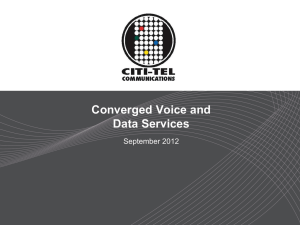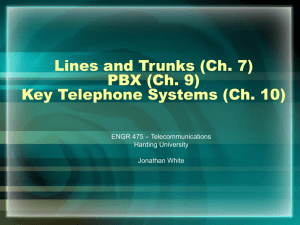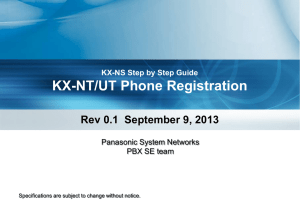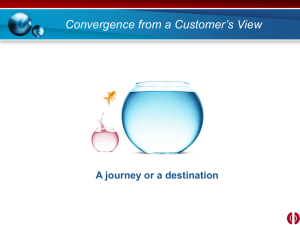Unit 2 Lesson 1 PBX Fundamentals
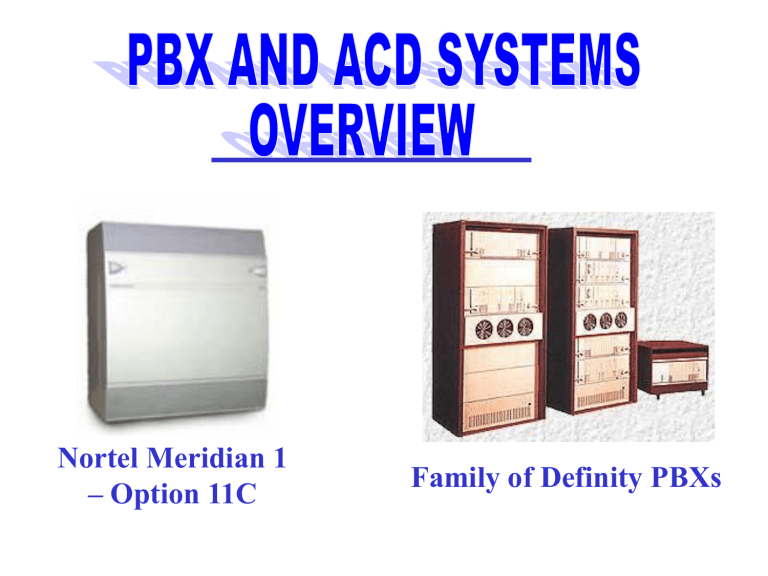
Nortel Meridian 1
– Option 11C
Family of Definity PBXs
Nortel Business
Key Telephones
Thought For The Week
No Question Is A Bad Question!
Lessons In Unit 2:
PBX Fundamentals
PBX Features And Functions
PBX Configurations
DEFINITY ECS Hardware
PBX Networking
Basics Of Automatic Call Distributor
Key Point
PBX Systems Are Similar To CO
Switches.
Like CO Switches, PBX Systems Are Powerful
Computerized Systems That Offer A Wide
Range Of Sophisticated Features.
At the End of Lesson 1, You Should Be
Able To:
Describe the Main Components Of A PBX
Explain How A Call Is Made Through A PBX
Define Direct Inward Dialing (DID)
Name and Briefly Describe Key PBX Functions
Name and Briefly Describe Common Auxiliary
PBX Equipment
PBX Components
The General Structure of Most PBXs Is
Similar, And Includes The Following
Major Components, Shown On The PBX
Components Diagram:
Trunks To Connect The PBX To The Telephone
Company
Extension Lines To Connect The PBX To
Internal Telephones
PBX Components
Continued
Equipment Cabinet: Main Processor, Trunk
Cards, And Line Cards
Telephones And Attendant Console
Administrative Terminal
PBX Components
Trunks
The Connections Between A PBX And CO
Switch Are Called Trunks. Trunks Are
Usually Large-Capacity Connections.
Businesses Configure Their Trunks
Depending On Their Telephone Systems,
Business Needs, and Employee Calling
Patterns.
PBXs Can Connect To Three Types Of
External Networks.
Extension Lines
The Connections From Individual
Telephone Sets To The PBX Are Called
Lines, Or Extension Lines.
Each Line Is Formed By A Twisted Pair Of
Copper Wire, And Is Assigned A Telephone
Extension Number By The PBX
Administrator.
Equipment Cabinet
The Equipment Cabinet, A Large Metal
Box In The Main Equipment Room, Is The
Heart Of The PBX.
Much of the Cabinet’s Circuitry Is
Contained On Electronic Circuit Cards
That Slide Into Slots And Plug Into A Main
Processor Board.
Equipment Cabinet
Most of Equipment Cabinets Are One Of
Two Main Types:
Trunk Cards Contain The Circuitry Necessary
To Communicate With the CO Switch.
Station Cards Contain the Circuitry Necessary
To Communicate With Internal Telephone
Extensions.
Telephones and Attendant Console
Telephone Sets Are Designed To Work
With A Particular PBX System.
Each PBX Telephone Set Includes
Programmable Features That Can Be
Enabled Or Disabled By The Company’s
Telephone System Administrator.
Administrative Terminal
A Computer Workstation Provides
Administrative Access to the PBX System.
The Company
’ s Telephone Administrator
Uses The System To Configure The Wide
Range of Features And Options Available.
Line Card Densities Across PBXs Vary From
Eight To 32 Ports Per Card (How Have We
Encountered Line Card Density In The Lab?)
Cable Pairs Required For A Proprietary
Telephone
One Pair Of Cables Is Always Required For Analog
Telephones.
Digital Telephones Can Require Two, Or More Pairs
Of Cables.
Distinctive-Code Feature Access
User’s Access A PBX’s Principle Features By
Code Dialing.
*7 – Call Pickup
*3 – Call
Forwarding
*8 – Call Hold
Examples Of Distinctive Code Feature Access
Single-Button Feature Access
User’s Access A PBX’s Principle Features By
Dialing Individual Single Buttons.
Call Pickup
Call Forwarding
Call Hold
Examples Of Single-Button Features Access
Making a Call on a PBX
Making A Telephone Call Within A PBX
Environment Is Very Similar To Making A Call
From Home Using The Public Telephone Network.
When You Lift The Receiver, Placing the
Telephone In The Off-hook Position, The
Telephone Signals The PBX That It Needs A
Connection.
The PBX Then Sends Dial Tone To The Extension
Telephone, And Waits For Incoming Touch Tones.
Call Routing
The Primary Function Of A PBX Is To
Provide Internal Access To
Telecommunications Trunks Provided By
A Telephone Company.
A PBX Can Queue, Or Hold, Calls Until A
Trunk Becomes Available.
Supplementary PBX Features
In Addition To Its Core System Features, A
PBX Can Provide Many Supplementary
Services:
Call Hold
Music On Hold
Hunting
Call Restrictions Or
“
Class of Restriction
Call Tracking
Direct Inward Dialing (DID)
DID Connects Incoming Callers Directly
To The Employees They Need To Talk
With.
DID Is An Effective Means Of Increasing
Customer Contact While Reducing The
Load On PBX Operators.
Direct Inward System Access (DISA)
Direct Inward System Access (DISA)
Allows An Outside Caller To Dial Directly
Into The PBX System, Then Access The
System
’ s Features And Facilities Remotely.
DISA Is Typically Used to Allow Employees
To Make Long Distance Calls From Home
Or Any Remote Area, Using The
Company
’ s Less Expensive Long Distance
Service.
Enables Callers To Dial A Telephone Number
And A Password To Gain Access To PBX
Features.
NYC Office Chicago Office
Business Traveler
CO – Class 5 Switch
Tie Line
Long Distance Network
Restricted Verses Unrestricted DISA Feature.
Security With DISA Is A Problem.
Station Set Features
Many Telephone Sets Now Include Special
Function Keys To Access Popular Functions
Such As:
Call Forwarding
Call Transfer
Speaker Paging
Speed Dialing
Message Waiting Light
Attendant Console Services
PBX Operators Are Often The Most Vital
Part Of A Company
’ s Information System.
In Addition, They Can Provide The
Following Key Functions From The PBX
Operator Console:
Call Processing
Company Directory Assistance
Organizing
“
Meet-Me
”
Conference Calls
Night Service
Camp On
Administration and Management Reports
The Following Management Features
Provide Detailed Information On Calls
Being Processed And Completed Through
A PBX System.
Call Detail Reports (CDRs)
Test Reports
Busy-Hour Studies
PBX Enhancements
A Variety Of Other Systems Can Be Added
To A PBX To Provide Specialized And
Enhanced Services.
Voice Response
Voice Recognition
Call Following
Automated Call Distributor (ACD)
Follow-Me Forward – User Keeps The PBX
Informed As To Where She Or He Is, i.e. Office,
Number, Home Number, Cell Number.
Choices Change – Caller Preference
Home No.
Outside Caller
Cell No.
Work No.
PBX Enhancements
Follow-Me Call Flow
Other Auxiliary Equipment
Other Common Types Of Auxiliary
Equipment Include:
Station Message Detail Reporter (SMDR)
Uninterruptible Power Supply (UPS)
Direct Station Selector (DSS)
Headset
PBX Costs And Requirements
In Addition To The One-time Installation
Cost, A PBX System Usually Incurs The
Following Ongoing Charges:
Equipment Maintenance, Upgrades
Lease or Finance Charges
Trunk Usage
DID Termination Service Charge
DID Numbers In Blocks of 10, 20, or 100
Office Space, Heating/Cooling, Electrical Power
Staff Salaries And Training
